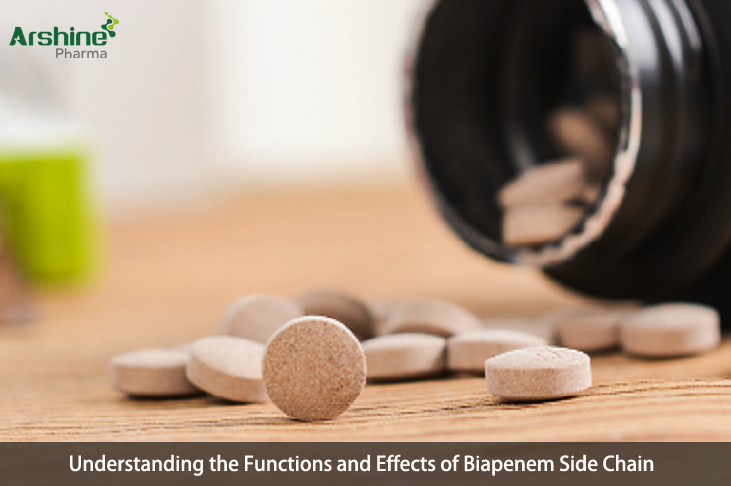Biapenem, a member of the carbapenem class of antibiotics, is a potent and broad-spectrum antibacterial agent used in the treatment of various bacterial infections. Its effectiveness stems from its unique chemical structure, particularly its side chain, which plays a crucial role in its pharmacological properties and therapeutic actions.
Introduction to Biapenem

Biapenem belongs to the β-lactam group of antibiotics, which includes penicillins, cephalosporins, and carbapenems. Its molecular structure consists of a beta-lactam ring fused to a five-membered thiazolidine ring, conferring stability against bacterial β-lactamases – enzymes that can render antibiotics ineffective by breaking down their β-lactam ring.
The side chain of Biapenem distinguishes it from other carbapenems. The side chain variation in carbapenems influences their pharmacokinetics, spectrum of activity, and stability against bacterial enzymes, thereby affecting their efficacy and clinical utility.
Understanding the Side Chain of Biapenem
The side chain of Biapenem consists of a hydroxyethyl group linked to the C-2 position of the β-lactam ring. This modification contributes significantly to its pharmacological profile, distinguishing it from other carbapenems such as meropenem, imipenem, and doripenem, which have different side chains. The presence of the hydroxyethyl moiety impacts the drug's interaction with bacterial targets and metabolic pathways, influencing its overall effectiveness and spectrum of activity.
Functions of the Biapenem Side Chain
1. Stability Against β-lactamases
One of the primary functions of the Biapenem side chain is to confer stability against β-lactamase enzymes produced by bacteria. β-lactamases are responsible for breaking down the β-lactam ring, rendering antibiotics ineffective. The hydroxyethyl side chain in Biapenem enhances its resistance to degradation by these enzymes, thereby ensuring its efficacy against a broader spectrum of bacteria, including those that produce β-lactamases.
2. Improved Pharmacokinetics
The unique side chain structure of Biapenem also contributes to its pharmacokinetic properties. It influences the drug's absorption, distribution, metabolism, and excretion within the body. The presence of the hydroxyethyl group might impact factors such as protein binding, tissue penetration, and renal clearance, thereby affecting the drug's overall pharmacokinetic profile and optimizing its therapeutic efficacy.
3. Enhanced Antibacterial Activity
The specific structure of the side chain in Biapenem contributes to its enhanced antibacterial activity against a wide range of Gram-positive and Gram-negative bacteria. The hydroxyethyl modification allows Biapenem to effectively penetrate the bacterial cell wall and bind to penicillin-binding proteins (PBPs), essential enzymes involved in bacterial cell wall synthesis. This binding disrupts cell wall formation, leading to bacterial cell death and exerting potent bactericidal effects.
4. Broader Spectrum of Activity
The side chain variation in Biapenem expands its spectrum of activity against various bacterial strains. Its stability against β-lactamases enables it to combat resistant bacteria that produce these enzymes, making it an essential antibiotic in treating infections caused by multidrug-resistant organisms.
Effects of Biapenem Side Chain on Clinical Use
1. Treatment of Infections
Biapenem's unique side chain structure enhances its efficacy in treating a wide array of bacterial infections. It is commonly used in clinical settings to manage respiratory tract infections, urinary tract infections, skin and soft tissue infections, intra-abdominal infections, and septicemia caused by susceptible bacteria.
2. Management of Resistant Strains
The stability of Biapenem against β-lactamases makes it a valuable option in combating infections caused by multidrug-resistant bacteria. It serves as a crucial therapeutic agent in scenarios where other antibiotics might be ineffective due to bacterial resistance mechanisms.
3. Importance in Healthcare Settings
Biapenem's effectiveness against resistant bacterial strains is particularly significant in healthcare settings where nosocomial (hospital-acquired) infections are prevalent. Its use can help in managing and containing the spread of drug-resistant pathogens, thereby reducing the risk of severe infections and complications in vulnerable patients.
Conclusion
The side chain of Biapenem, specifically the hydroxyethyl group, plays a pivotal role in determining its pharmacological properties, spectrum of activity, and clinical effectiveness. This modification enhances its stability against β-lactamases, broadens its spectrum of antibacterial activity, and contributes to its efficacy against multidrug-resistant bacterial strains.
Biapenem stands as a testament to the importance of chemical modifications in antibiotics, showcasing how alterations in molecular structures can significantly impact their pharmacodynamics and clinical utility. Further research and understanding of these chemical modifications continue to be crucial in the development of novel antibiotics with improved efficacy and resistance profiles in the ongoing battle against infectious diseases.
